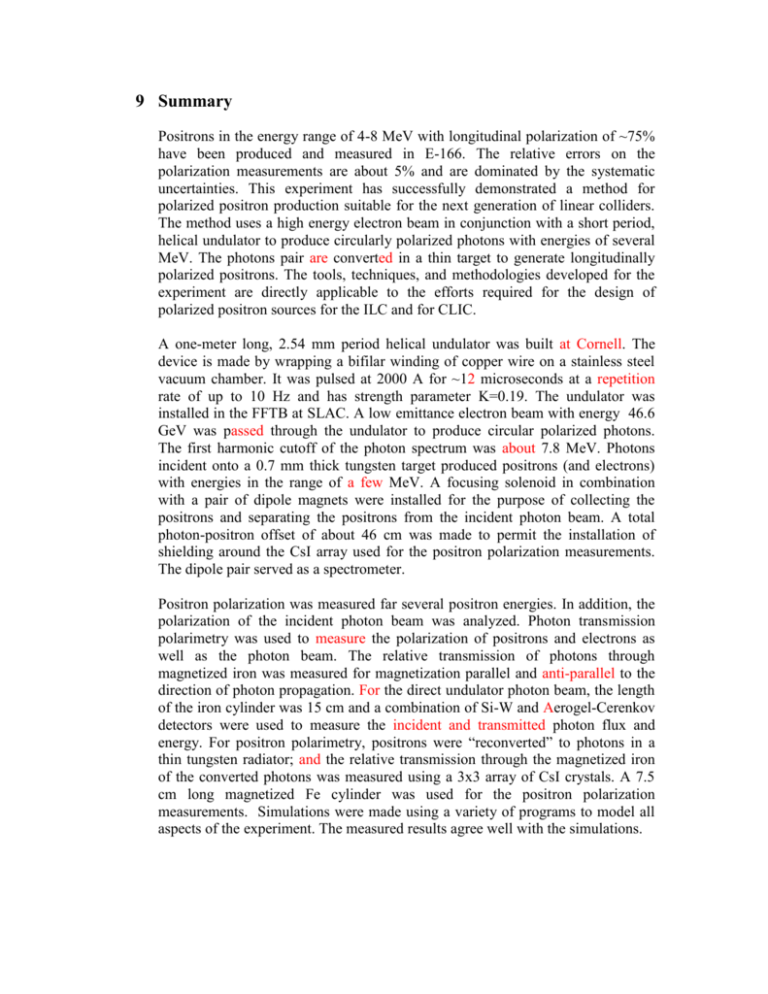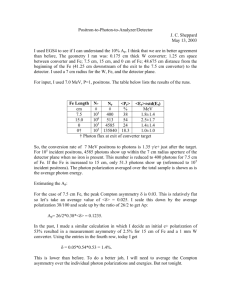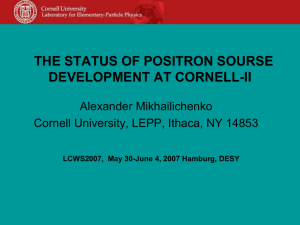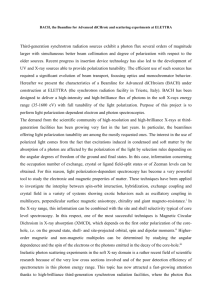Chapter9SummaryBuggedit
advertisement

9 Summary Positrons in the energy range of 4-8 MeV with longitudinal polarization of ~75% have been produced and measured in E-166. The relative errors on the polarization measurements are about 5% and are dominated by the systematic uncertainties. This experiment has successfully demonstrated a method for polarized positron production suitable for the next generation of linear colliders. The method uses a high energy electron beam in conjunction with a short period, helical undulator to produce circularly polarized photons with energies of several MeV. The photons pair are converted in a thin target to generate longitudinally polarized positrons. The tools, techniques, and methodologies developed for the experiment are directly applicable to the efforts required for the design of polarized positron sources for the ILC and for CLIC. A one-meter long, 2.54 mm period helical undulator was built at Cornell. The device is made by wrapping a bifilar winding of copper wire on a stainless steel vacuum chamber. It was pulsed at 2000 A for ~12 microseconds at a repetition rate of up to 10 Hz and has strength parameter K=0.19. The undulator was installed in the FFTB at SLAC. A low emittance electron beam with energy 46.6 GeV was passed through the undulator to produce circular polarized photons. The first harmonic cutoff of the photon spectrum was about 7.8 MeV. Photons incident onto a 0.7 mm thick tungsten target produced positrons (and electrons) with energies in the range of a few MeV. A focusing solenoid in combination with a pair of dipole magnets were installed for the purpose of collecting the positrons and separating the positrons from the incident photon beam. A total photon-positron offset of about 46 cm was made to permit the installation of shielding around the CsI array used for the positron polarization measurements. The dipole pair served as a spectrometer. Positron polarization was measured far several positron energies. In addition, the polarization of the incident photon beam was analyzed. Photon transmission polarimetry was used to measure the polarization of positrons and electrons as well as the photon beam. The relative transmission of photons through magnetized iron was measured for magnetization parallel and anti-parallel to the direction of photon propagation. For the direct undulator photon beam, the length of the iron cylinder was 15 cm and a combination of Si-W and Aerogel-Cerenkov detectors were used to measure the incident and transmitted photon flux and energy. For positron polarimetry, positrons were “reconverted” to photons in a thin tungsten radiator; and the relative transmission through the magnetized iron of the converted photons was measured using a 3x3 array of CsI crystals. A 7.5 cm long magnetized Fe cylinder was used for the positron polarization measurements. Simulations were made using a variety of programs to model all aspects of the experiment. The measured results agree well with the simulations. Undulator performance was modeled using MERMAID. Its performance was characterized by measuring the total photon flux as a function of excitation current and by measurement of the flux and energy transmitted through magnetized iron. The measured photon characteristics agreed well with expectations. At the end of the run, the transformer oil in the undulator container was replaced with ferro-fluid; and an enhancement of the flux was observed. The undulator itself was tested at currents up to 2300 A. During the data runs, it was pulsed at 10 Hz and 2000 A. Over 4x107 undulator pulses were made over the course of the run with out a single failure. Undulator photon polarization was explored by comparing the relative transmission asymmetry of the undulator spectrum through a 15 cm long, magnetized iron cylinder. The analysis relies upon the spectral transmission properties of magnetized iron and the polarization dependent term in the Compton scattering within the iron. The processes were modeled using a version of GEANT3 modified to include spin dependent scattering effects. Si-W and Aerogel detectors used for the measurements have different spectral responses and hence give somewhat different values for the asymmetry. The measured asymmetries agreed well with the expectations. In addition to photon polarization measurements, a Si-flux counter was used to measure the total photon flux produced from the undulator. Again, the measured flux as a function of undulator strength agreed well with predictions. Positron polarization was measured at 6 different energy setting of the analyzing spectrometer. In addition, an electron polarization measurement was measured at a single energy setting by reversing the polarity of the spectrometer. Over the measured energy range of 4-8 MeV, the positron (and electron) polarization was about 75% and a relative measurement error of about 5%. The measured results agree well with the model predictions. To do the modeling, GEANT4 has been updated to include a number of spin dependent effects. The spin updates have been incorporated in the standard version of GEANT4 and are available to all users. The modeling tools developed for E166 are being used to design the undulatorbase polarized positron sources for the next generation of linear colliders. The agreement of undulator performance, collection, and analyzing systems with expectation serve to benchmark the validity of the design methodologies.











